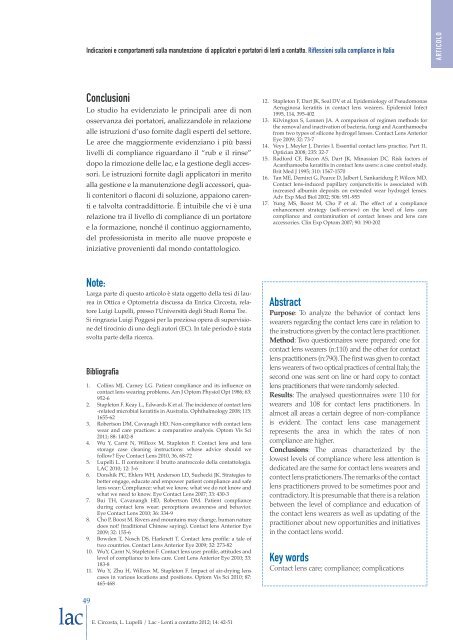Agosto - Cibavisionacademy.it
Agosto - Cibavisionacademy.it
Agosto - Cibavisionacademy.it
You also want an ePaper? Increase the reach of your titles
YUMPU automatically turns print PDFs into web optimized ePapers that Google loves.
Indicazioni e comportamenti sulla manutenzione di applicatori e portatori di lenti a contatto. Rifl essioni sulla compliance in Italia<br />
Conclusioni<br />
Lo studio ha evidenziato le principali aree di non<br />
osservanza dei portatori, analizzandole in relazione<br />
alle istruzioni d’uso forn<strong>it</strong>e dagli esperti del settore.<br />
Le aree che maggiormente evidenziano i più bassi<br />
livelli di compliance riguardano il “rub e il rinse”<br />
dopo la rimozione delle lac, e la gestione degli accessori.<br />
Le istruzioni forn<strong>it</strong>e dagli applicatori in mer<strong>it</strong>o<br />
alla gestione e la manutenzione degli accessori, quali<br />
conten<strong>it</strong>ori o fl aconi di soluzione, appaiono carenti<br />
e talvolta contradd<strong>it</strong>torie. È intuibile che vi è una<br />
relazione tra il livello di compliance di un portatore<br />
e la formazione, nonché il continuo aggiornamento,<br />
del professionista in mer<strong>it</strong>o alle nuove proposte e<br />
iniziative provenienti dal mondo contattologico.<br />
Note:<br />
Larga parte di questo articolo è stata oggetto della tesi di laurea<br />
in Ottica e Optometria discussa da Enrica Circosta, relatore<br />
Luigi Lupelli, presso l’Univers<strong>it</strong>à degli Studi Roma Tre.<br />
Si ringrazia Luigi Poggesi per la preziosa opera di supervisione<br />
del tirocinio di uno degli autori (EC). In tale periodo è stata<br />
svolta parte della ricerca.<br />
Bibliografi a<br />
1. Collins MJ, Carney LG. Patient compliance and <strong>it</strong>s infl uence on<br />
contact lens wearing problems. Am J Optom Physiol Opt 1986; 63:<br />
952-6<br />
2. Stapleton F. Keay L., Edwards K et al. The incidence of contact lens<br />
-related microbial kerat<strong>it</strong>is in Australia. Ophthalmology 2008; 115:<br />
1655-62<br />
3. Robertson DM, Cavanagh HD. Non-compliance w<strong>it</strong>h contact lens<br />
wear and care practices: a comparative analysis. Optom Vis Sci<br />
2011; 88: 1402-8<br />
4. Wu Y, Carnt N, Willcox M, Stapleton F. Contact lens and lens<br />
storage case cleaning instructions: whose advice should we<br />
follow? Eye Contact Lens 2010, 36, 68-72<br />
5. Lupelli L. Il conten<strong>it</strong>ore: il brutto anatroccolo della contattologia.<br />
LAC 2010; 12: 3-6<br />
6. Donshik PC, Ehlers WH, Anderson LD, Suchecki JK. Strategies to<br />
better engage, educate and empower patient compliance and safe<br />
lens wear: Compliance: what we know, what we do not know and<br />
what we need to know. Eye Contact Lens 2007; 33: 430-3<br />
7. Bui TH, Cavanangh HD, Robertson DM. Patient compliance<br />
during contact lens wear: perceptions awareness and behavior.<br />
Eye Contact Lens 2010; 36: 334-9<br />
8. Cho P, Boost M. Rivers and mountains may change, human nature<br />
does not! (trad<strong>it</strong>ional Chinese saying). Contact lens Anterior Eye<br />
2009; 32: 155-6<br />
9. Bowden T, Nosch DS, Harknett T. Contact lens profi le: a tale of<br />
two countries. Contact Lens Anterior Eye 2009; 32: 273-82<br />
10. WuY, Carnt N, Stapleton F. Contact lens user profi le, att<strong>it</strong>udes and<br />
level of compliance to lens care. Cont Lens Anterior Eye 2010; 33:<br />
183-8<br />
11. Wu Y, Zhu H, Willcox M, Stapleton F. Impact of air-drying lens<br />
cases in various locations and pos<strong>it</strong>ions. Optom Vis Sci 2010; 87:<br />
465-468<br />
49<br />
E. Circosta, L. Lupelli / Lac - Lenti a contatto 2012; 14: 42-51<br />
12. Stapleton F, Dart JK, Seal DV et al. Epidemiology of Pseudomonas<br />
Aeruginosa kerat<strong>it</strong>is in contact lens wearers. Epidemiol Infect<br />
1995, 114, 395-402<br />
13. Kilvington S, Lonnen JA. A comparison of regimen methods for<br />
the removal and inactivation of bacteria, fungi and Acanthamoeba<br />
from two types of silicone hydrogel lenses. Contact Lens Anterior<br />
Eye 2009; 32: 73-7<br />
14. Veys J, Meyler J, Davies I. Essential contact lens practice. Part 11.<br />
Optician 2008; 235: 32-7<br />
15. Radford CF, Bacon AS, Dart JK, Minassian DC. Risk factors of<br />
Acanthamoeba kerat<strong>it</strong>is in contact lens users: a case control study.<br />
Br<strong>it</strong> Med J 1995; 310: 1567-1570<br />
16. Tan ME, Demirci G, Pearce D, Jalbert I, Sankaridurg P, Wilcox MD.<br />
Contact lens-induced papillary conjunctiv<strong>it</strong>is is associated w<strong>it</strong>h<br />
increased albumin depos<strong>it</strong>s on extended wear hydrogel lenses.<br />
Adv Exp Med Biol 2002; 506: 951-955<br />
17. Yung MS, Boost M, Cho P et al. The effect of a compliance<br />
enhancement strategy (self-review) on the level of lens care<br />
compliance and contamination of contact lenses and lens care<br />
accessories. Clin Exp Optom 2007; 90: 190-202<br />
Abstract<br />
Purpose: To analyze the behavior of contact lens<br />
wearers regarding the contact lens care in relation to<br />
the instructions given by the contact lens pract<strong>it</strong>ioner.<br />
Method: Two questionnaires were prepared: one for<br />
contact lens wearers (n:110) and the other for contact<br />
lens pract<strong>it</strong>ioners (n:790). The fi rst was given to contact<br />
lens wearers of two optical practices of central Italy, the<br />
second one was sent on line or hard copy to contact<br />
lens pract<strong>it</strong>ioners that were randomly selected.<br />
Results: The analysed questionnaires were 110 for<br />
wearers and 108 for contact lens pract<strong>it</strong>ioners. In<br />
almost all areas a certain degree of non-compliance<br />
is evident. The contact lens case management<br />
represents the area in which the rates of non<br />
compliance are higher.<br />
Conclusions: The areas characterized by the<br />
lowest levels of compliance where less attention is<br />
dedicated are the same for contact lens wearers and<br />
contect lens pratictioners. The remarks of the contact<br />
lens pract<strong>it</strong>ioners proved to be sometimes poor and<br />
contradictory. It is presumable that there is a relation<br />
between the level of compliance and education of<br />
the contact lens wearers as well as updating of the<br />
pract<strong>it</strong>ioner about new opportun<strong>it</strong>ies and in<strong>it</strong>iatives<br />
in the contact lens world.<br />
Key words<br />
Contact lens care; compliance; complications<br />
ARTICOLO



